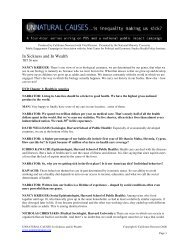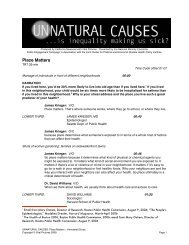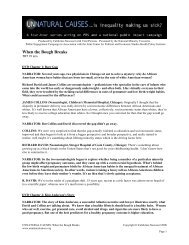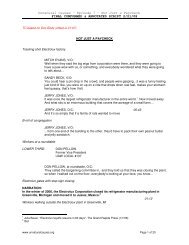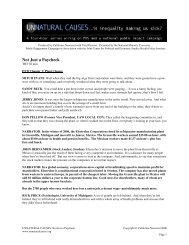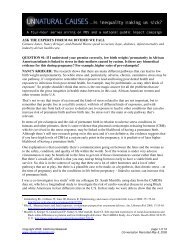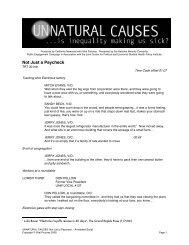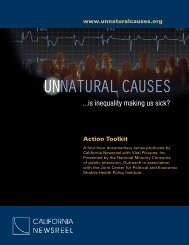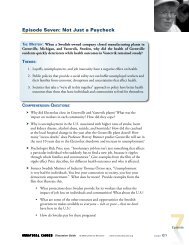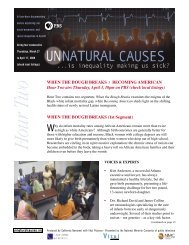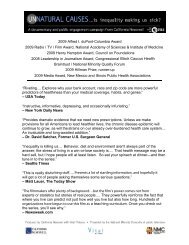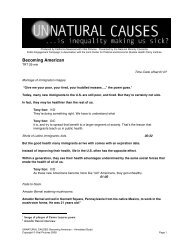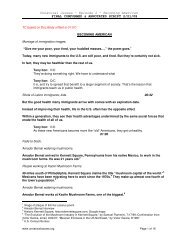Annotated - Unnatural Causes
Annotated - Unnatural Causes
Annotated - Unnatural Causes
Create successful ePaper yourself
Turn your PDF publications into a flip-book with our unique Google optimized e-Paper software.
Shots from newborn division in hospital<strong>Unnatural</strong> <strong>Causes</strong> – Episode 1 – In Sickness and In WealthFINAL CONFORMED & ANNOTATED SCRIPT 2/21/08A HIGHER PERCENTAGE OF OUR BABIES DIE IN THEIR FIRST YEAR OF LIFE THAN IN MALTA,SLOVENIA, CYPRUS. 6Medical collageHOW CAN THIS BE?IS IT JUST BECAUSE 47 MILLION OF US HAVE NO HEALTH CARE COVERAGE? 7KAWACHI (PARTIALLY O/C):Health care can deal with the diseases and illnesses. But a lack of health care is not thecause of illness and disease. It’s like saying that since aspirin cures a fever that lack ofaspirin must be the cause of the fever.hospital staff leaving the hospital, misc scenes on street[01:02:48]SO…. WHY ARE WE GETTING SICK IN THE FIRST PLACE? IS IT OUR AMERICAN DIET,INDIVIDUAL BEHAVIORS?KAWACHI:Those behaviors themselves are in part determined by economic status. So our ability toavoid smoking and eat a healthy diet depends in turn on our access to income,education, and what we call the social determinants of health.WRITTEN INTO OUR BODIES IS A LIFETIME OF EXPERIENCE – SHAPED BY SOCIALCONDITIONS, OFTEN EVEN MORE POWERFUL THAN OUR GENES. 8NANCY KRIEGER:Among twins who lived together until age 18, who basically grew up in the samehouseholds, so had at least a relatively similar exposure, if they diverged later in life, ifone became professional and the other was working-class, they ended up with differenthealth status as adults. This is among identical twins.CHRISTAKIS:There are ways in which our society is organized that are bad for our health. There’s nodoubt there’s ways we can reconfigure ourselves in ways that would benefit our health.Dr. Adewale Troutman with kids[01:04:4]DR. ADEWALE TROUTMAN KNOWS THIS IS TRUE IN LOUISVILLE KENTUCKY.Sound up with kids saying: “.. you’re a doctor?”Troutman: “I’m a doctor now. I’m the director of health for Louisville. I’m a physician.’TROUTMAN (V/O):I have the primary responsibility of overseeing the public health of over 700,000 people inthis community.Troutman: “…think about a back up, just in case you don’t make the NBA?”TROUTMAN OC:www.unnaturalcauses.org Page 2 of 28
<strong>Unnatural</strong> <strong>Causes</strong> – Episode 1 – In Sickness and In WealthFINAL CONFORMED & ANNOTATED SCRIPT 2/21/08I do push personal responsibility, I do push self determination in health, but it has to beseen in the context of the broader issues of social determinants. Which are the majorforces that shape the health outcomes of people and communities.Troutman: “… you did a fantastic job.”THE DETAILS ARE IN THE DATA.Sheila Andersen showing GIS maps: “This map shows infant mortality rates, in the east very low infantmortality rates… “TROUTMAN (V/O):For Louisville, we’ve generated data maps to get a clearer picture of what conditionscorrelate to illness and death across our city.[01:04:54]Sheila Andersen showing GIS maps: “Death rates from lunch cancer, little bit better outcome in theeast… “TROUTMAN VO:So the lighter shades mean lower rates of death and illness, and the darker shades meanhigher rates.Sheila Andersen showing GIS maps: “The highest rates of death from diseases of the heart are in theWest End. And that even …”Tracking shot of cemeteryEMBEDDED IN THE DATA IS A SOMEWHAT MORBID BUT REVEALING INDICATOR OFPOPULATION HEALTH… EXCESS DEATH. 9TROUTMAN:The notion of excess death says that you should be able to predict in any one time framehow many people in a population will die. And if the number that actually die is higherthan that, that differential is excess death, premature death, death that should not havehappened.KRIEGER:It’s not as if we won’t die. We all will die. But the question is: At what age? With whatdegree of suffering? With what degree of preventable illness?Sheila Andersen showing GIS maps: “And then these are death rates from all types of cancer. And yousee the same pattern.”IN SOME AREAS, PEOPLE DIE THREE…. FIVE …. EVEN TEN YEARS SOONER THAN IN OTHERS.10 CANCER AND HEART DISEASE ARE ALMOST TWICE THE RATE IN SOME AREAS AS INOTHERS. 11 [01:06:02]BUT LOUISVILLE HAS MANY FACES.Montage of images.ITS POPULATION IS SPREAD OVER 26 NEIGHBORHOODS, OR COUNCIL DISTRICTS. 12EACH WITH ITS OWN SOCIAL AND ECONOMIC ENVIRONMENT…AND EACH WITH A DISTINCTHEALTH PROFILE. 13www.unnaturalcauses.org Page 3 of 28
<strong>Unnatural</strong> <strong>Causes</strong> – Episode 1 – In Sickness and In WealthFINAL CONFORMED & ANNOTATED SCRIPT 2/21/08Troutman driving.TROUTMAN:And the further east you get the more affluent the communities become.[01:06:32]FURTHEST EAST AND NORTH IS COUNCIL DISTRICT SIXTEEN - HOME TO JIM TAYLOR. 14TAYLOR IS A FATHER, GRANDFATHER AND A CEO. 15Scene with Taylor family at barbecue: so is this going to be like when your Board chairman came and thegrill didn’t work?TAYLOR:I like to think of myself as a pretty healthy person. I’m only 12 months away from the 60thyear of my existence and I feel pretty healthy. I can’t do the things I did when I was 20now that I’m almost 60, but I can do most of them in a little moderation.Scene with Taylor family at barbecue: Is James gonna be here too? I like James…[01:07:12]LIKE MANY RESIDENTS HERE 16 , TAYLOR EARNS WELL INTO THE SIX FIGURES. 17 HIS INCOMEPLACES HIM IN THE TOP 1% OF AMERICANS. 18 THE WEALTH OF THAT 1% IS GREATER THANTHAT OF THE BOTTOM 90% -- COMBINED. 19JIM TAYLOR (O/S PARTIALLY):We’re fortunate that the choices we have may be greater than people who have lessmeans than we do. I have a neighborhood where I can be outside and know that I’msafe. That I can exercise and walk. And I know that not every neighborhood in thiscountry or in this city, that’s true.EXCESS DEATH DOESN’T SEEM TO BE A HEALTH ISSUE IN COUNCIL DISTRICT 16.HERE LIFE EXPECTANCY IS NEARLY 80 YEARS 10 – TWO YEARS LONGER THAN THE NATIONALAVERAGE. 4NICHOLAS CHRISTAKIS (O/S PARTIALLY):Most people can quite readily appreciate the fact that if you have more money you’regoing to be healthier. But it also turns out that that observation holds not just at theextremes. So for example, let’s say that there’s a ladder. It’s not just that the rich differ insome way from the poor in some kind of black-white or yes-no or zero-one kind of way.There’s a fine gradation all the way along this ladder, both in wealth and in health.[01:08:33]Misc scenes in mall, Whitehall studies article animationRESEARCHERS HAD WONDERED ABOUT THIS FOR DECADES. 20a BUT IN THE 1970S, THEPIONEERING WHITEHALL STUDIES OFFERED HARD DATA. SIR MICHAEL MARMOT HAS BEENLEAD RESEARCHER. 20bMisc shots of office workersMARMOT:I was interested in how social influences affect disease. And so we looked at people’sgrade in the hierarchy, their employment grade.OVER MORE THAN THIRTY YEARS, MARMOT AND HIS TEAM CHARTED THE HEALTH OF 29,000www.unnaturalcauses.org Page 4 of 28
BRITISH CIVIL SERVANTS. 20b<strong>Unnatural</strong> <strong>Causes</strong> – Episode 1 – In Sickness and In WealthFINAL CONFORMED & ANNOTATED SCRIPT 2/21/08MARMOT (O/S PARTIALLY):When we did this in the 1970s, the conventional wisdom was that it was the businessexecutive who had a high rate of heart attacks. And what we found in Whitehall was thelower the grade of employment, the higher the risk of heart disease. But not just heartdisease – every major cause of death.So if you were second from the top, you had worse health than if you were at the top; ifyou were third from the top, you had worse health than if you were second from the top ---- all the way from top to bottom.[01:09:40]IN BRITAIN EVERYONE HAS GUARANTEED HEALTH CARE. 21STILL, MARMOT FOUND THAT DEATH RATES AND ILLNESS CORRELATED TO STATUS, EVENAFTER HE CONTROLLED FOR UNHEALTHY BEHAVIORS. 20cMARMOT:A combination of smoking, blood pressure, cholesterol, overweight, sedentary life styleexplained no more than about a quarter of the social gradient in mortality. So heartdisease among smokers, if a poor person’s smoking, he or she has a higher rate ofdisease than if a wealthy person is smoking.Montage of Americans intercut with Marmot on cameraMARMOT:When a classless country like the United States said we wouldn’t find that here, becausewe don’t have social classes like they do in Britain. And of course once people started tolook at the United States, they found social gradients in disease of the same order asthose we found in Britain.Misc shots of people on escalator, animation of narration statistics.IN AMERICA THE WEALTH HEALTH GRADIENT LOOKS LIKE THIS. OVER 70% OF AFFLUENTAMERICANS REPORT VERY GOOD TO EXCELLENT HEALTH 22a – ALMOST TWICE AS MANY ASPOOR AMERICANS. NO SURPRISE.BUT IN THE MIDDLE LEVELS, GOOD HEALTH DECREASES SIGNIFICANTLY.THIS TRANSLATES INTO A REVERSE SLOPE FOR CHRONIC DISEASE.[01:11:12]DIABETES. LOW INCOME AMERICANS HAVE TWICE THE RATE OF DISEASE AS THE AFFLUENT.22bAND FOR THOSE IN THE MIDDLE, IT’S STILL ALMOST TWICE THE RATE.A SIMILAR PATTERN HOLDS FOR STROKE 22c … HEART DISEASE 22d …. EVENTUALLYCONTRIBUTING TO EXCESS DEATH, ESPECIALLY FOR MIDDLE AND LOW INCOME AMERICANS.Ballgame intercut with Marmot on cameraMARMOT:The conditions that show up in stark form in the poor health of the poor, are showing upin somewhat less stark form in people who we don’t think of as poor. The large mass inthe middle of society are also being affected.We find these social gradients in health everywhere.www.unnaturalcauses.org Page 5 of 28
<strong>Unnatural</strong> <strong>Causes</strong> – Episode 1 – In Sickness and In WealthFINAL CONFORMED & ANNOTATED SCRIPT 2/21/08Troutman driving, various neighborhoodsTROUTMAN (V/O):When I first came to Louisville I was struck by how different the various communitieslook. And I began to wonder and then understand that there’s a direct connectionbetween the health of the populations in Louisville and the social conditions that can beseen as you go from one council district to another.[01:12:20]Shots of neighborhoods, Tondra Young at home, at library/campusSOUTH OF JIM TAYLOR’S HOME IS COUNCIL DISTRICT 24.TONDRA YOUNG LIVES HERE. 14 YOUNG IS 37, A LAB SUPERVISOR – AND SHE’S JUST GOTTENENGAGED. 23TONDRA YOUNG (O/C PARTIALLY):Financially, I’m comfortable. I’d like to be rich someday, but right now I’m fine. I’m doinga whole lot better than my mom was. Just bought a new home. And I would describe myfamily as a middle class family now, ya I would.TO GET AHEAD, TONDRA WENT BACK TO COLLEGE WHILE WORKING FULL TIME. 23TONDRA (V/O):I am going to graduate in the spring, I’m very excited about that. I’ve traveled a longways to even get to that point.RESEARCH SHOWS THAT COLLEGE GRADUATES LIVE ON AVERAGE TWO AND A HALF YEARSLONGER THAN HIGH SCHOOL GRADUATES. 24TROUTMA (V/O):Education offers a way to move up the wealth gradient, it connects to the type of job, itconnects to optimism about the future. But getting it depends on whether or not you canafford it.[01:13:44]TONDRA’S DEGREE HAS LEFT HER $20,000 IN DEBT, ON TOP OF HER MORTGAGE. 23Tondra & Christian gardening: Leave the worm along. – I think I broke him.IN THE LAST FIVE YEARS, THE COST OF COLLEGE HAS INCREASED 35%. 25Basketball game, animation of stats in narrationONLY 15% OF ADULTS IN TONDRA’S COUNCIL DISTRICT, HAVE A COLLEGE EDUCATION,COMPARED WITH OVER 63% IN JIM TAYLOR’S DISTRICT. 26 LIFE EXPECTANCY HERE IS 75YEARS, FOUR YEARS LESS THAN IN JIM TAYLOR’S. 10Troutman driving to Corey’s neighborhood. MAP over aerial.NORTH WEST FROM TONDRA YOUNG’S DISTRICT IS COUNCIL DISTRICT 21. 14[01:14:21]THIS IS WHERE COREY ANDERSON LIVES WITH HIS WIFE ANGELIQUE AND THEIR TWOTEENAGERS. COREY’S LIVED IN THIS PART OF TOWN ALL HIS LIFE. 27aShots of Corey doing household chores, photos of Corey’s mother and younger CoreyCOREY:www.unnaturalcauses.org Page 6 of 28
<strong>Unnatural</strong> <strong>Causes</strong> – Episode 1 – In Sickness and In WealthFINAL CONFORMED & ANNOTATED SCRIPT 2/21/08This is my mother. This is the woman who taught me how to iron my clothes – put mycreases in, get the wrinkles out. I give her all the praise and the glory for teaching mehow to keep myself nice and neat.WHEN COREY WAS YOUNG, HIS MOM WORKED FULL TIME. AND HER JOB WAS MORE THANJUST A PAYCHECK. 27bCOREY (O/S PARTIALLY):She had just purchased the house, everything was going great for me – I’m doing good,you know, I’m being blessed. Then all of a sudden, ya know, the company moved.It took a major toll on her when she lost her job. She got ill, her blood pressure went up,y’know, and had to go to the doctor more often. It was just something that really took atoll on her, y’know, mentally and physically. As well as me and my brother.EVENTUALLY COREY’S MOM DID FIND WORK, BUT SHE HAD TO LEAVE HER HOME 27b – FORMOST AMERICANS HOME OWNERSHIP IS A WAY TO BUILD FINANCIAL SECURITY. 28ANGELIQUE:I always wanted to have a house with a big back yard, with a fence, and my kids couldrun around, have their own room. A basement.COREY (O/S PARTIALLY):A basement, with a pool table… I want to own a house. I want both of us to own a house.So that if anything happened to me, she wouldn’t be put out on the street.[01:16:17]COREY AND ANGELIQUE BOTH WORK FULL TIME. 27a THEIR COMBINED SALARIES PLACETHEM RIGHT AT THE NATIONAL MEDIAN INCOME. 17 ABOUT $48,000. 29 HALF OF ALLAMERICAN HOUSEHOLDS LIVE AT THIS INCOME LEVEL – OR BELOW.COREY:As far as like saving, we don’t earn enough to say we’re going to put away $250 anddon’t touch it …ANGELIQUE:It’s going to have to take to work two jobs to really make it.COREY:You ain’t working two jobs.ANGELIQUE:I didn’t say me.Corey grilling, animation of statistics in narrationAT 37, COREY HAS ALREADY BEEN DIAGNOSED WITH HYPERTENSION. JOINING ONE THIRDOF THE RESIDENTS IN COUNCIL DISTRICT 21. 30AVERAGE LIFE EXPECTANCY HERE IS TWO YEARS SHORTER THAN IN TONDRA’S COUNCILDISTRICT – SIX YEARS LESS THAN IN JIM TAYLOR’S. 10Troutman driving down Broadway in the rain.[01:17:25]TROUTMAN SEES SOCIAL CONDITIONS CHANGE EVEN MORE MARKEDLY AS HE DRIVESTHROUGH LOUISVILLE CITY CENTER, ACROSS NINTH STREET.www.unnaturalcauses.org Page 7 of 28
<strong>Unnatural</strong> <strong>Causes</strong> – Episode 1 – In Sickness and In WealthFINAL CONFORMED & ANNOTATED SCRIPT 2/21/08TROUTMAN:There’s almost a cultural demarcation in the city where on one side of this particularstreet, 9th street, there’s a tremendous amount of new development going on, condosrising up. The downtown business environment is very much alive. And right across thestreet on Ninth Street, is where the beginnings of the first set of projects are, publichousing projects…Troutman driving down Broadway in the rain, various store frontsTROUTMAN:Very little business in this area… primarily fast foods, small business, barbershops,beauty salons, pawn brokers, nail parlors, check cashing, liquor stores. Payday cash.Cash when it counts.And it seems like every place has a Ninth street. Whether it’s 110th Street in Harlem orSouth Side of Chicago. Or sections of Watts…ANA DIEZ ROUX:Of course these differences are not a natural thing. It’s not the design of nature thatthese environments are going to be different. They arise as a result of policies or theabsence of policies that create these enormous inequalities and resources. 52 [01:18:54]TROUTMAN (V/O):Is there adequate access to chain supermarkets in this area? The answer is no. As amatter of fact, why aren’t there zoning laws to regulate fast food outlets here? Enterprisezones to build businesses? Better transportation? Why isn’t there more mixed incomehousing? You know, all these things and others are health policy.Troutman driving. Louisville map.HOW SOCIAL POLICIES CAN DRIVE HEALTH, BECOMES EVEN MORE APPARENT IN COUNCILDISTRICT 5. THE HOME OF MARY TURNER. 14Mary leaving her houseMary driving, with voice over about the neighborhood: This is where we usually come down for shoes,school shoes and school clothes…up here is Save A Lot,,,,A THIRD OF THE RESIDENTS HERE HAVE NEVER RECEIVED A HIGH SCHOOL DIPLOMA. 26ALMOST 30% LIVE AT OR BELOW THE POVERY LINE. LIKE MARY. 16 [01:19:54]LIFE EXPECTANCY IN MARY’S COUNCIL DISTRICT IS MORE THAN 3 YEARS LESS THAN INCOREY’S DISTRICT, 9 YEARS LESS THAN IN JIM TAYLOR’S. 10MARY TURNER:Of course we’re dying young….. versus 80 in the eastern section of the county. Y’know,because those people are more affluent, and they have things open to them.MARY IS 49, WITH THREE CHILDREN AT HOME. HER HUSBAND IS DISABLED. 31MARY TURNER:You have to eat what fits your budget. So when you get these, a family size, and they’re$1.99, and you can feed four people with it. You know, versus … maybe four with $4… Imean, what’s your choice going to be? Especially on a $200 a month budget for food.www.unnaturalcauses.org Page 8 of 28
<strong>Unnatural</strong> <strong>Causes</strong> – Episode 1 – In Sickness and In WealthFINAL CONFORMED & ANNOTATED SCRIPT 2/21/08The food that we buy would last about 2 weeks. We spend cash for the first part of themonth, when we get Social Security and SSI. And then usually by the last two weeks ofthe month, things are getting really spare, y’know, I got like 3 teenagers, so about the endof the month I start reducing to one meal a day, so I make sure the kids got everythingthey need.12% of THE RESIDENTS HERE ARE UNEMPLOYED 16 – MORE THAN DOUBLE THE NATIONALAVERAGE. 32 AS IS MARY FOR NOW. SO SHE VOLUNTEERS AT THE NEIGHBORHOOD MUSEUMSHE LOVES. 31Mary at the Portland MuseumMARY CONTINUES (V/O PARTIALLY):I do feel like sometimes things are out of control …Because as soon as you try to betteryourself…I mean if I even get a job, you know, then I might lose my medical coverage,and my medical coverage is necessary. You know, because I have to have mymedications in order to work. I had a heart attack several years ago. It was mild, but itwas still a heart attack. Thyroid problems, you know. And arthritis, you know, a little bitof everything.[01:22:00]ITON (O/C MOSTLY):We can predict on aggregate, based on where somebody lives, high school graduationrates, and their income 33 … …how long they will live and when they will die. Now,obviously there’ll be exceptions to that…but for the most part we’ll be right. And weshould not be able to do that. Your life expectancy, how long you will live, should not bedependent on essentially the resources you have accessible to you…Misc shots, Tondra Young at school, hospital, streetsACT TWOSYME (O/C PARTIALLY):We know that social class is the most important determinant above any other risk factor.But what does social class mean? Is it housing, or medical care? Education?OR IS IT POWER, CONFIDENCE, A SENSE OF SECURITY?SYME:Which one of those is most important? Hopeless, they’re all inextricably intertwined,can’t take them apart…so it’s really a challenge…[01:23:04]BUT HOW DO WE CARRY SOCIAL CLASS IN OUR BODIES? HOW DOES IT GET UNDER OURSKIN?SYME:As you go through the alternative explanations, the one that seemed most impressive tome was this idea of control of destiny. I don’t like that word. What I mean by it is theability to influence the events that impinge on your life, even if it means not doinganything, but one way or the other, managing those pressures.MARMOT:There’re all sorts of ways we’ve devised for depriving people of a sense of control overtheir lives. Living in a community where it’s not safe to go out.www.unnaturalcauses.org Page 9 of 28
<strong>Unnatural</strong> <strong>Causes</strong> – Episode 1 – In Sickness and In WealthFINAL CONFORMED & ANNOTATED SCRIPT 2/21/08ITON:Middle class families having to work two jobs. Middle class families not being able tospend with their kids….[01:23:50]Visuals include layered pix montage of Americans, Corey’s Mom, Mary TurnerMARMOT:Being relatively poor, having job insecurity. All of those things will decrease control overpeople’s lives, and all of those things are likely to increase risk of illness. And there aregood biological reasons why that might be the case.WHEN WE FEEL THREATENED OR DON’T HAVE CONTROL IN OUR LIVES, ONE CRITICALBIOLOGICAL REACTION KICKS IN - THE STRESS RESPONSE. 34Pix: woman running in garage, pull in to her eyeballAnimationWHEN THE BRAIN PERCEIVES A THREAT, IT SIGNALS THE ADRENAL GLANDS TO RELEASEPOTENT STRESS HORMONES. AMONG THEM CORTISOL. THEY FLOOD YOUR BLOODSTREAMWITH GLUCOSE, INCREASE YOUR HEART RATE, RAISE BLOOD PRESSURE …THEY PUT YOURBODY ON ALERT...[01:24:37]MCKEWAN:Cortisol improves memory, enhances immune function. It helps you re-establish energysupplies. Mother Nature put all of this stuff in there to help us survive.Tennis courtWILLIAMS:Stress helps to motivate us… In our society today everybody experiences stress. In fact,the person who has no stress is a person who is dead.A NORMAL STRESS RESPONSE SPIKES UP WHEN NEEDED, THEN TURNS OFF.Factory workersBUT WHAT HAPPENS WHEN PRESSURES ARE RELENTLESS AND YOU LACK THE POWER ANDRESOURCES TO CONTROL THEM? WHEN THE STRESS RESPONSE STAYS TURNED ON … FORMONTHS? OR YEARS? 54MCKEWAN (O/S PARTIALLY):These systems begin to work overtime. We produce too much cortisol. Chronically,cortisol can impair immune function… it can actually inhibit memory and can even causeareas of the brain to shrink…MARMOT (O/S PARTIALLY):When you get prolonged activation of these stress pathways… they in turn affect heartrate variability, the ability to handle insulin and glucose, and those in turn, we think,increase risk of diabetes and heart disease.KAWACHI:Because of the stresses, the wear and tear in the body’s systems is reflected ultimately inhigher rates of disease and accelerated aging.www.unnaturalcauses.org Page 10 of 28
<strong>Unnatural</strong> <strong>Causes</strong> – Episode 1 – In Sickness and In WealthFINAL CONFORMED & ANNOTATED SCRIPT 2/21/08[01:26:08]UNIVERSITY HOSPITAL. LOUISVILLE’S MAJOR TEACHING HOSPITAL. YOU’D EXPECT TO SEETHE WEAR AND TEAR OF STRESS IN THE BODIES OF PATIENTS. 35BUT AS A LARGE HIERARCHICAL WORKPLACE, MUCH LIKE ANY OTHER, UNIVERSITYHOSPITAL REVEALS MORE. STRESS IS EVERYWHERE.VISUAL MONTAGE: PORTRAIT OF A BUSY HOSPITAL. Feature: doctors confabbing, people in foodservices prepping meals, people filing papers and doing clerical workKRISTI:There are days where the pager that I carry goes off non-stop. And it gives me a horribleheadache. And I just think that the next time I hear a page or a beep, I’m going to throwit against the wall.COREY ANDERSON, FLOOR TECHNICIAN, IS STRESSED. SO IS TONDRA YOUNG, SUPERVISOROF A CLINICAL LAB. AND JIM TAYLOR, CEO OF THE HOSPITAL IS STRESSED. 35 [01:27:02]BUT NEITHER CHRONIC STRESS NOR ITS HEALTH EFFECTS ARE EQUALLY DISTRIBUTED ON AHIERARCHY.Macaques outside. Shively voiceovers.Shively: Alright, that’s a chase and a flee. That one is dominant over the one that ran away.CONSIDER THIS HIERARCHY…. OF MACAQUE MONKEYS.PRIMATOLOGIST CAROL SHIVELY HAS BEEN STUDYING MACAQUES FOR ALMOST 30 YEARS.36SHIVELY (V/O):Same thing happened. He can play that game all day long with her, cause he’s dominant.It’s a very mild sort of harassment.SHIVELY:A dominant animal has complete control over his life. He can go wherever he wants inthe pen to do whatever he wants. Take over the favorite resting places, eat the choicefood, That animal has all the control that it needs to create an optimal environment forhimself.In contrast, subordinate animals have almost no control over what happens to them.They have to be watching all the time. With that high level vigilance comes increases inheart rate.MACAQUES WITH LESS POWER AND CONTROL ARE IN A STATE OF CHRONIC STRESS. THEEVIDENCE IS IN THEIR STRESS HORMONE LEVELS.[01:28:16]SHIVELY:They have higher levels of cortisol circulating in their blood. It’s the same chemical that isreleased in human beings in response to stress. And when it is sustained at high levels itstarts having negative effects on cellular function and tissues.www.unnaturalcauses.org Page 11 of 28
<strong>Unnatural</strong> <strong>Causes</strong> – Episode 1 – In Sickness and In WealthFINAL CONFORMED & ANNOTATED SCRIPT 2/21/08Visuals: lab shots, macaques going through the MRI, slides, microscopeSHIVELY CAN ACTUALLY LOOK INTO THE HEARTS OF MACAQUES TO SEE THE DAMAGEFROM CHRONIC STRESS.[01:28:41]SHIVELY:This is a cross-section of the artery of a dominant monkey. The hole in the center islarge and that means that there’s lots of room for blood to flow through. This is the arteryof a subordinate animal. So what’s happened here is that a subordinate monkey hasdeveloped a much larger atherosclerotic plaque than a dominant animal, who lived for thesame amount of time, ate the same amount of diet and so on and so forth. And that issimply due to the stress of social subordination.Now if this monkey keeps developing atherosclerosis at this increased rate relative to thismonkey, this one is going to end up with an artery that is completely compromised andhave a myocardial infarction.IN OTHER WORDS, A HEART ATTACK. 37 [01:29:47]Kids playing, riding tricycles.MONKEYS ARE ONE THING, HUMANS ARE ANOTHER. DO WE SEE A SIMILAR PATTERN?THAT’S WHAT PSYCHOLOGIST SHELDON COHEN WANTED TO KNOW.HE USED THE SAME STRESS MEASURE SHIVELY USED, LEVELS OF CORTISOL. 38aCold study scene, researcher calls “who’s next?”COHEN:We have people chew on little cotton swabs till they get wet. And take it and analyze it forcortisol.HE COMPARED THEIR LEVELS WITH THEIR SOCIO-ECONOMIC STATUS.COHEN:And to tell you the truth, I’m always somewhat surprised when I see these data. It turnsout the more education you have, the less cortisol you release during the day. The moreincome you have, the less cortisol you release during the day.[01:30:33]THEN COHEN WANTED TO TEST THE EFFECT OF STRESS ON OUR BODIES. HIS FOCUS, OURIMMUNE SYSTEM.COHEN:Basically we brought healthy people in, we exposed them to a virus. We actually do thisby putting a drop in their nostrils that has a cold virus in it.COHEN’S FINDING? THOSE WITH LESS CHRONIC STRESS CAUGHT FEWER COLDS THANTHOSE WITH MORE STRESS.WHILE A COLD VIRUS MAY SEEM MINOR, IT COULD SIGNAL MORE SERIOUS HEALTHPROBLEMS.COHEN (O/C PARTIALLY):[01:31:11]www.unnaturalcauses.org Page 12 of 28
<strong>Unnatural</strong> <strong>Causes</strong> – Episode 1 – In Sickness and In WealthFINAL CONFORMED & ANNOTATED SCRIPT 2/21/08The cold study is a paradigm we can use that allows us to see how effectively theimmune system is operating...which has implications for not only colds and otherinfectious diseases, autoimmune diseases and some kinds of cancers.SO…HIGHER STATUS, LESS STRESS. LESS STRESS, BETTER IMMUNE FUNCTION.Jim Taylor scene: you still like this place compared to where you were?BEING CEO IS A HIGH DEMAND JOB. BUT TAYLOR USUALLY HAS THE POWER, RESOURCESAND CONTROL TO MANAGE THAT PRESSURE. 53Scene with TondraTONDRA YOUNG HAS A HIGH DEMAND JOB, BUT LESS POWER AND CONTROL.TONDRA:Sometimes it can get a little stressful, because I have 50 something employees runningaround, on three different shifts, three different building, sometimes it can be tough forme, because everybody’s not like the decisions that I’ve made for the department, but I’mmaking the best decisions for the department and for patient care.Corey scrubbing floor, manager: “looking good in here.”COREY:The control that I have on my job is limited.[01:32:26]COREY ANDERSON’S JOB REQUIRES HIM TO RESPOND TO A LOT OF DEMANDS FROM ABOVE.Corey on the phoneCOREY:Yes, mission is complete up on the first floor, I want to know what my next project is.IN ONE SCENARIO – COREY IS FIRST TOLD TO CLEAN PATIENT ROOMS.COREY (O/S PARTIALLY):But I got pulled to help out with trash… so I started on the trash and when I pull the trash,I got a page to tell me to go back to the rooms….I was bounced around.Corey on the phone “you want these scrubbed?”Corey and supervisorLIKE COREY, ONE IN EVERY FIVE AMERICAN MEN WORKS IN A HIGH DEMAND/ LOW CONTROLJOB. 39a [01:33:10]THEY’RE MORE LIKELY TO EXPERIENCE HIGH BLOOD PRESSURE AT WORK. AND …THEIRBLOOD PRESSURE DOESN’T FALL AS MUCH AS MEN WITH MORE CONTROL – EVEN WHENTHEY SLEEP. 39bCorey and TaylorMARMOT:www.unnaturalcauses.org Page 13 of 28
<strong>Unnatural</strong> <strong>Causes</strong> – Episode 1 – In Sickness and In WealthFINAL CONFORMED & ANNOTATED SCRIPT 2/21/08It’s not only about work. It’s about where you are in the hierarchy, and how that relates tothe circumstances in which you live, grow up, as well as work.COREY:So this is basically what I call my neighborhood. I don’t venture no farther, because I just,I’m not comfortable with venturing back there, and back over that way. A lot of things dooccur back in the back. And my wife she knew a cab driver who was murdered backthere in the back.ANGELIQUE:Two cab drivers, one got shot in the head. The other one got shot and they dropped himoff in his yard. Remember that, Corey? Right over here on Kingston?COREY:I thought he got strangled.ANGELIQUE:Oh yeah, they strangled him. And then they shot another young boy…[01:34:23]THE ACCUMULATION OF STRESSORS….. OR THE ACCUMULATION OF RESOURCES TOMANAGE THEM, SO MUCH IS DETERMINED BY CLASS. 53Back to Jim Taylor at home:TAYLOR (O/C PARTIALLY):I’m well paid for what I do. I’m fortunate enough to be able to have the choice of wherewe live. More than half the mornings when I come to work, I have to stop for that deer togo by, and that kind of thing is just what happens in this neighborhood.We have the time to exercise, because the lives we live don’t require us to try to find abus that we have to ride for two hours to get to our job. And on the other end, we don’thave huge demands on us when we’re not working.[01:35:09]TAYLOR (O/C PARTIALLY):Jackie and I talked a lot about healthy choices of eating. Well, that doesn’t come for free.We have the ability to get to places, where one can make those choices. We have thetime to prepare the meal that we had the money to buy.So a certain economic status brings you control over other parts of your life… the kinds ofplaces you can live, the kinds of vacations you can take, or if you can take a vacation.Scene: Stills of Corey and Angelique on vacation.Corey and Angelique at homeANGELIQUE:We went by bus. All the way from here to Miami. We got on this party bus. And once wegot on that boat, brother… it was over for me.COREY:Throw your hands up…that’s how she was…..www.unnaturalcauses.org Page 14 of 28
<strong>Unnatural</strong> <strong>Causes</strong> – Episode 1 – In Sickness and In WealthFINAL CONFORMED & ANNOTATED SCRIPT 2/21/08ANGELIQUE:I was like hallelujah! No kids… It was just a break, a piece of… It’s just something that weneeded. We never get to go nowhere. We’re always with the kids or babysittingsomebody else’s kids…Rain and river scene[01:36:18]MARY:Vacation to me is going to the park, sitting by the river and watch the river flow by. That’smy vacation, little short things. It’s not, there’s no family vacations, it doesn’t happen.Family photosMARY TURNER:And my children, I think they’re living with whole lot of stress. A whole lot, you know. Andthey are, you know, kind of at a loss for doing anything about it. Y’know I mean, they’reyoung, what can they do? They don’t like being by themselves on the streets. They don’tlike to walk by themselves, they want somebody with them. That’s why you see themgoing two or three. Y’know. That happens a lot around here.CONTRARY TO SOME STEREOTYPES, MOST OF THE POOR IN AMERICA ARE WHITE. 40 MARYGREW UP POOR. HER CHILDREN JOIN THE 21% OF ALL AMERICAN CHILDREN WHO LIVE INPOVERTY. 41 [01:37:17]THE UNREMITTING STRESS OF CHILDHOOD POVERTY CAN HAVE LIFELONG HEALTHCONSEQUENCES.AnimationChildren playing at a tableJACK SHONKOFF:Just the burden of day after day not knowing whether there’s going to be food on thetable or not knowing whether you’re going to have a roof over your head, is actually toxicto the brain. 55SHONKOFF (O/C PARTIALLY):And the reason for that is because when the stress hormone levels go up, if it stays upfor days and weeks on end, those hormone levels literally interfere with the developmentof brain circuitry, they interfere with the development of the connections in the brain. Sowe begin to see in children who experience toxic stress long-term impacts of what’sbasically been chemically damaging to their brains. 55SHONKOFF:The concept here is the pile-up of risk, the cumulative burden of having things that areincreasing your chances of having problems, as opposed to the cumulative protection ofhaving things in your life that increase the likelihood that you can have better outcomes.ECONOMIC SECURITY MAY OFFER SOME OF THOSE CUMULATIVE HEALTH BENEFITS.[01:38:20]IN ANOTHER COLD VIRUS STUDY, COHEN USED A FAMILIAR PROXY FOR THAT SECURITY:38b & 28HOME OWNERSHIP.Cold studyCOHEN:www.unnaturalcauses.org Page 15 of 28
<strong>Unnatural</strong> <strong>Causes</strong> – Episode 1 – In Sickness and In WealthFINAL CONFORMED & ANNOTATED SCRIPT 2/21/08We asked people if their parents own their own home, does whether their parents ownedtheir own home when they were a kid predict whether they’d get a cold when you’re anadult. We now take them as an adult, we expose them to a virus - it turns out it’s a greatpredictor…and it’s a graded predictor. That is, the more years their parents owned ahome, the less likely they’d be to get a cold when we expose them to a virus.SHONKOFF:All of it really comes down to whether you’re building a strong or weak foundation in earlychildhood. When you pile up risk factors it ends up being translated into a weakerfoundation, a brain that’s been subjected to more disruption, an immune system that’sbeen more threatened.AND POOR OR NOT, IF YOU’RE NOT WHITE, THE PROGNOSIS CAN BE WORSE. 42 [01:39:21]Sequence of Troutman with kids at the Community Center, asking where they live.Teenages biking near riverADEWALE TROUTMAN (O/C PARTIALLY):I’m clear that on the social gradient, that line that we talked about earlier, that I’m on thetop of that line. I’m highly educated. I have a medical degree. I have several otherdegrees. I make good money. I live in a good neighborhood. But I know that accordingto the research, if you’re an African American, no matter what your social status, yoursocioeconomic status, your health outcomes are going to be worse than your whitecounterpart.AFRICAN AMERICANS DIE EARLIER AND HAVE HIGHER RATES THAN WHITES OF MANYCHRONIC DISEASES. ACROSS THE SOCIAL GRADIENT. 42SYME:Why should there be an elevated risk of disease in African Americans of higher socialclass? …Bad genetics…Not true. When you look at other countries where thediscrimination is not as prevalent you don’t find those kinds of rates. So something’shappening. 56TROUTMAN:As a physician, I’ve been followed around the store. When I go in to buy something, I’vebeen looked at askance. I’ve seen a woman grab her purse when I come into theelevator. And for goodness sake’s – I am Dr. Troutman! You know, why… This shouldn’thappen to me, but it does.[01:40:44]SYME:The whole idea of vigilance and the burden that it takes to be constantly on guard overtime, really does change biological markers and make people vulnerable to getting sick.Animation of racial discrimination/hypertension articleRACIAL DISCRIMINATION CAN BE AN ADDED STRESSOR, LINKED WITH HIGH BLOODPRESSURE… INCREASED RATES OF INFANT DEATH… CORONARY ARTERY DISEASE. 43TROUTMAN KNOWS WHAT THIS CAN LEAD TO. HE AUTHORED A CORNERSTONE STUDY WITHFORMER SURGEON GENERAL DAVID SATCHER ON EXCESS DEATH AMONG AFRICANAMERICANS. 44 ADEWALE TROUTMAN:www.unnaturalcauses.org Page 16 of 28
Plane on runway, in sky<strong>Unnatural</strong> <strong>Causes</strong> – Episode 1 – In Sickness and In WealthFINAL CONFORMED & ANNOTATED SCRIPT 2/21/08It was a national study and we found over 83,000 excess deaths per year in the AfricanAmerican community alone.83,000 EXCESS DEATHS EACH YEAR. THAT’S THE EQUIVALENT OF A MAJOR AIRLINER FILLEDWITH BLACK PASSENGERS FALLING OUT OF THE SKY EVERY SINGLE DAY EVERY YEAR. 45ACT THREE[01:41:51]Corey playing poolMARMOT (O/C PARTIALLY):If these inequalities in health, this gradient in health, was a fixed property of society andnever changed, then you’d say, “We’re stuck.” But that’s not the case.The magnitude of the inequalities in health changes over time. It can get rapidly worse,and if it can get rapidly worse, it ought to be possible to make it rapidly better.REDUCING HEALTH INEQUALITY IS NOT IMPOSSIBLE. AS A SOCIETY WE’VE DONE IT BEFORE.52Archival footageA CENTURY AGO THE AVERAGE AMERICAN LIVED ONLY ABOUT 48 YEARS. 46 AS LIVINGCONDITIONS AND MEDICAL CARE IMPROVED, WE BEGAN LIVING LONGER. THOSEIMPROVEMENTS REACHED MORE AMERICANS THROUGH SOCIAL REFORMS – LIKEUNIVERSAL EDUCATION, BETTER SANITATION, THE 8-HOUR WORK DAY, EVEN ACONTROVERSIAL TAX ON PERSONAL INCOME. 47 [01:43:03]Archival FDR: This social security measure…THE 1930S. AN ARRAY OF NEW SOCIAL PROGRAMS PREVENTED AN ECONOMIC CRISIS, FROMBECOMING AN EVEN WORSE HEALTH CRISIS. 48Archival FDR continues: …to increased services for the protection of children and the prevention of illhealth.Archival footage of returning WWII vetsRETURNING WORLD WAR II VETERANS GOT THE GI BILL. IT OFFERED HOMES ANDEDUCATION AND EVENTUALLY THE KIND OF WEALTH THAT SETS HEALTH ON AN UPWARDTRAJECTORY. 49 STILL, MOST AFRICAN AMERICANS WERE EXCLUDED. 49b [01:43:36]THE 1950s. THE MIDDLE CLASS WAS GROWING, INCOME INEQUALITY WAS DECLINING. 50PROSPERITY AND MEDICAL ADVANCES EXTENDED OUR LIVES EVEN LONGER. 46CHRISTAKIS (O/C PARTIALLY):But… the vast majority of improvements in health in our society over the last centuryhave had very little to do with medical innovation… What really counts, it’s other kinds ofthings we can do and those other kinds of things tend to be non-medical things. Like…thinking about the distribution of wealth in our society…or providing public healthinfrastructure…or better education for people, better housing. All of those things whicharen’t medical phenomena, it is all those that are really material for public health. 51www.unnaturalcauses.org Page 17 of 28
<strong>Unnatural</strong> <strong>Causes</strong> – Episode 1 – In Sickness and In WealthFINAL CONFORMED & ANNOTATED SCRIPT 2/21/08Speaker at Civil Right march: “Black and white together…”, archival ftg 1960’s African AmericansIN THE 1960s, CIVIL RIGHTS LAWS, ANTI-POVERTY PROGRAMS, MEDICARE AND MEDICAID 57 ….ALL BROUGHT THE BENEFITS OF PROSPERITY TO THOSE WHO HADN’T YET SHARED IN IT.DAVID WILLIAMS (O/C PARTIALLY):During the 1960s, to early ‘70s the black-white gap in income narrowed, 58a and the blackwhitegap on multiple indicators of health also narrowed. 58b What this says veryeloquently is that economic policy is a health policy. And when we improve economiccircumstances and narrow the economic gap we improve the health.CHRISTAKIS (O/C PARTIALLY):So we can potentially intervene or potentially see a world in which while we do noteliminate hierarchy, we constrain the way in which hierarchy affects human beings. Soit’s not just that the people at the top can afford those things and get them, and those atthe bottom that do not not, if we provide them to all, we still have some hierarchy, butnow we’ve kind of reduced the disparities.[01:45:32]BUT SINCE THE 1980S WE’VE GONE IN THE OPPOSITE DIRECTION. 58c1980s unemployment line. Soundbites: “I used to work for these people, now I gotta stand in line to get abox of cheese.” “Waiting for the Reagon trickle-down, and it’s not trickling.”IN THE MIDST OF A RECESSION 59a , GOVERNMENT SLASHED SOCIAL PROGRAMS 59b ,DEREGULATED INDUSTRY 59c , REDUCED TAXES FOR THE WEALTHY. 59dWITH CONSEQUENCES THAT REMAIN WITH US TODAY.Warren Buffett at Congressional Hearing:WARREN BUFFETT:In a country that prides itself on equality of opportunity, it is becoming anything but thatas the gap between the super rich and the middle widens in dramatic fashion. 60WARREN BUFFET, THE WORLD’S THIRD RICHEST MAN ….[01:46:15]BUFFETT:Here are a few figures on the Forbes 400. Other people save their Playboy magazines, Isave the Forbes 400 magazine. Twenty years ago, the total wealth of the list was then$220 billion. Now it’s $1.54 trillion, exactly a seven for one increase. Tax law changeshave benefited this group including me, in a huge way.WEALTH INEQUALITY REACHED A RECORD LOW IN 1976. SINCE THEN IT HAS SOARED. 61TODAY WE ARE FAR AND AWAY THE MOST UNEQUAL OF THE WORLD’S RICH DEMOCRACIES.62Tondra drivingBUFFETT:During that same period, the average American went exactly nowhere on the economicfront. He’s been on a treadmill while the super rich have been on a spaceship. 63WILLIAMS:www.unnaturalcauses.org Page 18 of 28
<strong>Unnatural</strong> <strong>Causes</strong> – Episode 1 – In Sickness and In WealthFINAL CONFORMED & ANNOTATED SCRIPT 2/21/08The poor are getting poorer and the middle class is getting squeezed. With what we knowin terms of health, that suggests that we will have even more health problems in thefuture. 63Tondra driving[01:47:24]THAT’S BECAUSE HERE, HEALTH DEPENDS LARGELY ON OUR INDIVIDUAL ASSETS ANDRESOURCES.ITON:In America, it’s the strongest relationship you’ll find anywhere, that wealth pretty muchequals health. And that’s true for me as it is true for you know the poorest person in thequote unquote inner city, and people living in the suburbs.Shots of misc in foreign countriesTHE WEALTH-HEALTH GRADIENT IS NOT AS STEEP IN MOST OTHER INDUSTRIALIZED64, 22NATIONS.MANY USE THEIR RESOURCES TO ENSURE THAT MORE OF THEIR CITIZENS HAVE THEFREEDOM TO LEAD FLOURISHING HEALTHY LIVES. 65 [01:48:07]ALL GUARANTEE UNIVERSAL HEALTH CARE COVERAGE. 66 …. MANDATE AT LEAST FOURWEEKS OF PAID VACATION. 67FRANCE’S MINIMUM WAGE HAS BEEN TWICE AS MUCH AS OURS. 68IRELAND PROVIDES FREE COLLEGE EDUCATION. 69SWEDEN’S FAMILY POLICIES REDUCE CHILD POVERTY TO A MERE 4.2% COMPARED TO OUR21%. 70 JACK SHONKOFF:It’s tragic actually that we are the richest country in the world and that we are far behindmany other countries in terms of how we use our resources to make life better for familieswith young children, and thereby invest in our future. 65ITON (O/C PARTIALLY):Those countries have found ways to break the tight linkage between income and wealthand health. And they invest in better education systems, housing support, childcare,access to recreation. They subsidize through tax policy, mechanisms that break thatstrong relationship. 65 Those countries where wealth is more equitably distributed arehealthier. 71Driving over bridge[01:49:30]HERE IN THE US, MANY COMMUNITIES ARE TAKING HEALTH MATTERS INTO THEIR OWN HANDS.Sound up on opening on Health Equities Center in Louisville. Continue sceneADEWALE TROUTMAN:I’m glad you’re here. I’m excited that you’re here because this is the mosaic of people,partnerships, organizations, agencies that we need to come together to make this areality.www.unnaturalcauses.org Page 19 of 28
<strong>Unnatural</strong> <strong>Causes</strong> – Episode 1 – In Sickness and In WealthFINAL CONFORMED & ANNOTATED SCRIPT 2/21/08IN LOUISVILLE, THE CITY’S NEW HEALTH EQUITY CENTER TRAINS CITIZENS TO TAKEPOLITICAL ACTION AND DESIGN POLICIES THAT ADDRESS THE HEALTH NEEDS OF THEIRCOMMUNITY. 72Troutman opening the Health Equity CenterHigh Point sceneTROUTMAN:It’s not enough to talk about individual behavior and feel that if we could just get people toexercise more and eat more fruits and vegetables everything would be all right. That isnot the case. The bigger issues are the social conditions that drive the ultimate healthstatus of populations.IN SEATTLE WASHINGTON COMMUNITY ACTIVISTS TARGET UNHEALTHY HOUSING – AND THEASTHMA THAT KEEPS MANY FROM LEADING PRODUCTIVE LIVES. 73 [01:50:31]Folks outside home, Tim Takaro inside a Breath Easy Unit: “The air is inside the home is actuallyhealthier than the air outside.”ADEWALE TROUTMAN (O/C PARTIALLY):Part of good public health is empowering communities. And I don’t think we should shyaway from that. And empowering communities means creating those conditions wherepeople become empowered and make the changes they need to control their lives.Power is a public health issue.Terrel at graveyard, “And here’s my grandpa. He died of diabetes, diabetes and the complications ofdiabetes”….IN ARIZONA NATIVE AMERICANS ARE FARMING AGAIN. WITH BETTER FOOD AND NEWECONOMIC RESOURCES, THEY ARE BEGINNING TO TAKE CONTROL OF THEIR DESTINIES –AND DIABETES. 74Cont Health Equity Center setting:TROUTMAN (O/C PARTIALLY):Of course the proof is in the pudding. The proof is in the next steps; what we canorganize, what we can implement, and how we’re able to move this communityahead….it’s about human rights, it’s about addressing the social determinants of health inorder to make a difference. It’s about fairness. It’s about health equity and social justice.[01:51:32]Mary Turner packs her car with groceriesTondra & boyfriend gardeningMARMOT (O/C PARTIALLY):We’ve got to create a movement where people understand we’re talking about leadingmore flourishing lives. We need to do certain things ‘cause they’re the right things to do.But it’s an issue of individual self-interest. If I live in a just society, I’ll benefit.ITON:An economist will tell you it’s inefficient to have people who could otherwise becontributing during their productive years to the overall benefit of society. Caught up inhospitals, that create a net dependence on society, so they’re drawing resources downfrom society rather than producing resources that benefit the society as a whole.www.unnaturalcauses.org Page 20 of 28
Taylor, hospital collage<strong>Unnatural</strong> <strong>Causes</strong> – Episode 1 – In Sickness and In WealthFINAL CONFORMED & ANNOTATED SCRIPT 2/21/08AND THE COST OF THAT LOST PRODUCTIVITY TO BUSINESS DUE TO CHRONIC ILLNESS, ISSTAGGERING. IT’S NOW ESTIMATED AT OVER ONE TRILLION DOLLARS A YEAR. 75 [01:52:36]WORSE, ONE STUDY PREDICTS THAT TODAY’S GENERATION OF YOUNG AMERICANS MAY BETHE FIRST IN A CENTURY TO LIVE SHORTER LIVES THAN THEIR PARENTS. 76TROUTMAN (O/C PARTIALLY):And I would hope that we would all be able to-to gravitate towards an egalitarian societywhere health is seen as a basic human right.Troutman with kids at the Y begins: “Somebody told me this table had the fastest kids in all of Louisville –is that true?TROUTMAN (O/C PARTIALLY):But even if you’re not willing to go that far, you’d better be involved in this because theself-interest would dictate that you’re at risk too.ITON (O/C PARTIALLY):We can wait for things to happen and try to repair them in this mode of damage control.Or we can invest early, try to set good trajectories for families and children incommunities…. We can do those things. Or we can engage in damage control. We havea choice…[01:53:48]END CREDITSFUNDER BEDwww.unnaturalcauses.org Page 21 of 28
<strong>Unnatural</strong> <strong>Causes</strong> – Episode 1 – In Sickness and In WealthFINAL CONFORMED & ANNOTATED SCRIPT 2/21/08APPENDIX: SOURCES01 (1) World Development Indicators Database, Bank, 4/23/07(2) World Economic Outlook Database (4/07), IMF02 CMS, National health expenditure data; KFF, How changes in medical technology affect healthcare costs”, March ‘07; NCHC, Health Insurance Cost (nchc.org/facts/cost.shtml)03 (1) Progressive Policy Institute, 1/17/07, Almost half of all world health spending is in the US(2) WHO Fact sheet #319, Spending on Health: a global overview, Feb 07 (‘04 data): globalexpenditure for health now at US$4.1tr http://www.who.int/mediacentre/factsheets/fs319/en/index.html04 (1) Thorpe et al: “Differences in disease prevalence as a source of the US-European Health Carespending gap”, Health Affairs (web exclusive), Oct 2, 07 (2) Banks, Marmot, et al: “Disease anddisadvantage in the US and in England”, JAMA, May 3, 06, vol 295, lno1705 (1) UNDP, HDR 2006 (’04 data): US average at 77.5 yrs = 30th (2) UNDP HDR ‘07/08: 77.9 yrs= 29 th (3) RWJF, Overcoming obstacles, 2008, p.38&3906 (1) UNDP HD Report 07/08 (UNICEF 2006 data): down to 6 IMR, Slovenia, Cyrpus, Malta better07 (1) US Census, “Income, Poverty, and Health Insurance Coverage in the US: 2006”: 15.8% =47m; (2) NCHC: nearly 47m (referencing Census '05 rpt);08 Nancy Krieger, “Twins’ health and adult socioeconomic status”, PLoS Medicine, vol 2.7. 7/0509 John Kimball, Biology pages @http://users.rcn.com/jkomball.ma.ultranet/Biologypages/E/Epidemiology…10a Michael Price, Kentucky Population Research, KSDC, life tables by census county subdivisionbased on 2000 US census dataNOTE: CCS are an area including several council districts, but per Price each of our four selected CD’sprobably quite representative11 (1) GIS Maps, Sheila Andersen, Louisville Metro Health for mortality by cancer and mortality byheart disease(2) Sheila Anderson, Louisville Metro Health, death rate data shows twice for lung cancer, more thantwice as high for heart disease12 City of Louisville, KY website: 26 council districts13 GIS Maps, Sheila Andersen, Louisville Metro Health14 GIS Maps, Sheila Andersen, Louisville Metro Health15 (1) University of Louisville Hospital, “new University medical Center board members are names”@ www. Uoflhealthcare.org/news(2) Taylor interview transcript of tape #100616a KSDC, census 2000 summary file 3, profile 8, area 16, p10: $110,989 mean household income,c.a. 3,142 of 10,411 earn > $100,00016b KSDC, census 2000 summary file 3, profile 8, area 5, p18: 29.2%16c KSDC, census 2000 summary file 3, profile 8, area 5, p. 5: 11.6%www.unnaturalcauses.org Page 22 of 28
<strong>Unnatural</strong> <strong>Causes</strong> – Episode 1 – In Sickness and In WealthFINAL CONFORMED & ANNOTATED SCRIPT 2/21/0817 Ken Marshall, ULH, email of 1/16/07 to Julie Crawford: Taylor’s income range: $343k-$470k;Corey’s income: $17k-25,6k; Angelique’s income estimated18 Emmanuel Saez, 2005 income tax data computations, available athttp://elsa.berkeley.edu/~saez/TabFig2005s.xls - see Table 1: income threshold for top 1% (incl capgains): $350,50119 Arthur Kennickel, Survey of Consumer Finances, Federal Reserve Board, “Currents andUndercurrents – changes in the distribution of wealth, 1989-2004”, Jan 30 ’06, table 11a(2) EPI, The State of Working America, table 5.7 (data source: Wolff, 2006)20a per Marmot email 1/31/08, Nancy Krieger in conversation with CHS20b (1) WHO Commission on Social Determinants of Health website; MacArthur Research Networkon Socioeconomic Status and Health(2) Ruth Bell email7/2/07: WHI ('67-69) = 2 yrs initially, follow up over 35 yrs, 19,019 subjects total; WHII('85-89) = 3 yrs init, follow ups over 24 yrs, 10,308 subjects(3) Robert Evans: “Why aresome people healthy and others not? – The Determinants of Health of Populations”, 1994, p5-920c Work, Stress and Health – the Whitehall II study, 2004 CCSU/Cabinet Office, p.4, downloadableat www.pcs.org.uk20-graph Whitehall study, per M. Marmot email 2/12/0821 European Observatory on Health Care Systems: Health Care Systems in Transition, p.522a RWJF, 2007 (NHIS 2001-5 data)Note: the original data categories were % of FPL, so these are approximations22b RWJF: Overcoming obstacles, p.22 (NHANES 1999-2004 data)22c RWJF (2007 preview for upcoming report using NHIS 2001-5 data))22d RWJF: Overcoming obstacles, p.22 (NHIS 2001-5 data)23 Tondra Young confirmed via phone 1/25/08 & email 4/26/0724 (1) Adriana Llenas-Muney email 5/9/07, referring to NBER paper she co-authored with DavidCutler, available at http://www.nber.org/digest/mar07/w12352.html25 (1) College Board, Trends in College Pricing, 2006, p.1026 Sheila Andersen, KSDC (2000 census data)27a confirmed in phone conversation w/ Angelique Anderson. Corey previously lived in differentneighborhood, but not far27b implied in interview transcript28 (1) White House Homeownership Policy Book - Background atwww.whitehouse.gov/infocus/homeownership/homeownership-policy-book-background.html(2) Woo et al, CFED, Measuring Ownership in America – CFED’s 2005 assets and opportunity scorecard29 US Cencus Bureau: Income, Poverty, and Health Insurance Coverage in the US, 200630 Sheila Andersen, Louisville Metro Health: 29.4% (BRFSS data 2005)NOTE: CCSs are an area, including several council districts, but each of our four selected CDs probablyquite representative31 Mary Turner confirmed in email 1/28/0832 BLS, CPS data at www.bls.gov/cps/home.htmwww.unnaturalcauses.org Page 23 of 28
<strong>Unnatural</strong> <strong>Causes</strong> – Episode 1 – In Sickness and In WealthFINAL CONFORMED & ANNOTATED SCRIPT 2/21/0833 (1) by L. Neergaard, AP, “Where you live linked to life expectancy – stark differences in longevityreported around the country”, 9/12/06 (2) RWJF, Overcoming obstacles to Health, p.17, 18, 68 (3) GISmaps various cities (4) Income - HUS 1998 (DC/NCHS); Vital & Health Stats 2006 (CDC/NCHS)34 Animation sequence (visuals and voice over) approved by medical animation advisors JudithSaide, Ass. Professor of Physiology and Biophysics, Boston University, and James Head, Prof ofPhysiology, BU (email of 2/12/07); further feedback and comments by Rebecca Stoltz and Jack Shonkoff,Harvard University (email of 6/29/07); plus information and comments from various other medical advisorscollected and forwarded by Al Race, Ctr on the Developing Child, Harvard School of Public Health(4/24/07 email)35 Ken Marshall, University of Louisville Hospital (email 6/28/07)36 Carol Shively email 12/18/0737 “Myorcardial infarction / heart attack”, Patient Health International atwww.patienthealthinternational.com38a S. Cohen et al, “Psychological stress and susceptibility to the common cold,” NEJM 325, 199138b S. Cohen et al, “Childhood Socioeconomic status and host resistance to infectious illness inadulthood,” Psychosom Med 66, 200438c Interior Health, Canada, “Beyond Health Services and Lifestyle – a social determinants approachto health,” Nov ‘0639a http://circ.ahajournals.org/cgi/content/full/92/3/327(1) Schnall et al., “Longitudinal study of job strain and ABP – results from a three-year follow up”,Psychosomatic medicine 60:697-706, 1998(2) Karasek, Theorell, Schwartz et al, “Job Characteristics in Relation to Prevalence of MyocardialInfarction in the US Health Examination Survey (HES) and the Health and Nutrition Examination Study(HANES)”, 1988 AJPH vol 78, no 839b (1) Peter Schnall et al., “Relation between job strain, alcohol, and ambulatory blood pressure”,Hypertension, vol 19, no 5, May 1992(2) Schnall et al., “Longitudinal study of job strain and ABP – results from a three-year follow up”,Psychosomatic medicine 60:697-706, 1998(3) R. Evans, “Why are some people healthy and others not?”(4) WHO – “The solid facts,” 2003, by Marmot & Wilkinson (ed)40 (1) Income, Poverty and Health Insurance Coverage in the US, 05 (Census); (2)HUS 2006;(3) RWJF, Overcoming Obstacles to Health, p. 3741 (1) EPI, The State of Working America (LIS ‘06 data)42 (1) RWJF, Overcoming obstacles to Health, pg. 26-7(2) data forwarded by Ernie Moy of Agency for Health care Research and Quality: (2a) 2004 MEPS dataon self-reported health status, 18-64 by education;(2b) Age-adjusted all cancer mortality per 100,000 pop, 25-64, by education, NVSS 2001; (2c)Infant mortality per 1,000 by education, NVSS 200343a (1) Steffen et al, “Effects of perceived racism & anger inhibition on ambulatory blood pressure inAfrican Americans,” Psychosomatic Medicine 65, 2003 (2) Profant & Dimsdale, “Race and diurnal bloodpressure patterns,” Hypertension 1999, 33 (3) Clark, “Self-reported racism & social support predict bloodpressure reactivity in Blacks, Annals of Behavioral Medicine,” 2003, vol 25, #243b (1) Lu & Lu, “Maternal nutrition & infant mortality in the context of relationality”www.unnaturalcauses.org Page 24 of 28
<strong>Unnatural</strong> <strong>Causes</strong> – Episode 1 – In Sickness and In WealthFINAL CONFORMED & ANNOTATED SCRIPT 2/21/08(2) Schoendorf et al, “Mortality among infants of black as compared with white college-educated parents,”NEJM, vol326, 1992 (3) Dzietham et al, “IM differences between whites and African Americans: effect ofmaternal education,” AJPH, 1998, vol 88, #443c Lewis et al, “Chronic exposure to everyday discrimination and coronary artery calcification inAfrican Am women,” Pscyhosom Med, 68, 2006, May-June44 Troutman & Satcher, “What if we were equal? A comparison of the black-white mortality gap in1960 and 2000” Health Affairs, 24, no 2, 200545 (1) 5/10/07 email from Bernhard Blome, Air Berlin pilot, confirming that capacities flexible, varywidely between airlines and planes, but from examples of some “typical” seating arrangements, a 227passenger capacity falls well into the range (83,000 / 365 = c.a. 227)46 National Vital Statistics Reports, vol 52, no 14, 2/18/04: Table 12. Estimated life expectancy atbirth in years by race and sex – death registration states, 1900-28 and US 1929-200147a-d (A) Public education in the United States, II. Elementary education and the common-schoolmovement, Microsoft Encarta Online Encyclopedia 2007(B) CDC: Achievements in public health, 1900-1999 – changes in the public health system(C) Learn about the Progressive Era, Digital History atwww.digitalhistoory.uh.edu/modules/progressivism/index.cfm;Robert Whaples, Wake Forest University, “Hours of Work in US History;”NYT 9/24/1916 “8-hour workday not arbitrable, Wilson asserts”(D) NYT 5/6/1913 “Bankers find fault in the income tax”48 (1) Waller, CE “Social Security Act in its relation to public health”, Am J Public Health NationsHealth, Nov 1935, 25(11), p. 1186-1194 (2) The Social Security Act, FDR Library atwww.fdrlibrary.marist.edu/oadssast.html (3) Social Security Act (1935), National Archives atwww.ourdocuments.gov(4) MCH/Public health milestones Part V: 1930-1939, slideshow by Alexander, GR et al49 (1) Hillary Herbold, “Never a level playing field: blacks and the GI bill”, The J of Blacks in HigherEducation, no 6 (Winter, 1994-1995), pp. 104-108(2) Ira Katznelson, When Affirmative Action was white – an untold history of racial inequality in twentiethcenturyAmerica, Norton & Co.(3) Tim Wise, “Bill of Whites”, ZNET, 7/24/2000 at www.zmag.org50a +b (A1) United States History – C. The middle class expands, MSN Encarta av. AtEncarta.msn.com/encyclopedia_1741500823/United_States_History(A2) Stephen Koepp, “Is the middle class shrinking?”, time.com, 11/3/1986,(B) US census historical income table F-2: share of aggregate income by quintiles51 (1) Interior Health, Canada, “Beyond Health Services and Lifestyle: a social determinantsapproach to health”, Nov ‘06, p.13(2) Woolf, S, “Giving Everyone the Health of the Education: An Examination of whether social changewould save more lives than medical advances,” AJPH, April ‘0752 Interior Health, Canada, “Beyond Health Services and Lifestyle: a social determinant approach tohealth,” Nov 0653 (1) Wilkinson & Marmot (ed), The solid facts, WHO 2003(2) Holly Avey, “How US Lows and social policies influence Chronic Stress and health disparities”, Politicsof race, culture and health symposium Ithaca College, 11/14/02www.unnaturalcauses.org Page 25 of 28
<strong>Unnatural</strong> <strong>Causes</strong> – Episode 1 – In Sickness and In WealthFINAL CONFORMED & ANNOTATED SCRIPT 2/21/0854 (1) “Early aging tied to chronic stress,” David Perlman, San Francisco Chronicle, 11/30/04(2) B. McEwen, “Protective and damaging effects of stress mediators,” Seminars in Med of the Beth IsraelMed Center, Vol 338 #3(3) R. Sapolsky, Sick of Poverty, Sci Am. 2005 Dec : 293 (6):92-955 (1) G. Evans et al, “The role of chaos in poverty and children’s socioemotional adjustment”Psychological science, vol 16, no 7, 2005(2) “Excessive Stress disrupts the architecture of the developing brain,” National Scientific Council on theDeveloping Child, working paper #3, summer 2005(3) “Beyond Health services and lifestyle, Interior Health,” Canada, Nov ‘0656 (1) Rotimi, Cooper, Ward, “The puzzle of hypertension in African-Americans,” Scientific American,2/6/99, av. At www.sciam.com(2) R. David et al, “Differing birth weight among infants of US born blacks, African born blacks and USborn whites,” NEJM 1997, vol 337, no 17(3) MacArthur Research Network on Socioeconomic Status and Health, “Discrimination”, Summaryprepared by D. Williams and the Psychosocial Working Group, revised Oct. 1998, av. atwww.macses.ucsf.edu/Research/Psychosocial/notebook/discrmination.html copyright 1999 UCSF,contact Judith Stewart(4) Gabrielle Amersbach, “Through the lens of race – unequal health care in America,” Harvard PublicHealth Review, winter 200257 (1) “The history of Medicare”, Social Security Online History pages, av atwww.ssa.gov/history/corning.html(2) US HSS – CMS: History Overview, at www.cms.hhs.gov/History58 Krieger N, Rehkopf DH, Chen JT, Waterman PD, Marcelli E, Kennedy M.“The Fall and Rise of US Inequities in Premature Mortality: 1960-2002,”PLoS Medicine, February 26, 2008, Volume 5, Issue 258a (1) US Census Historical Income Table F-5(2) “Black and white balance sheet”, Time/CNN, 1/24/1969, at www.time.com58b (1) Table 12. Estimated life expectancy at birth in years, by race and sex: death-registrationStates, 1900-28, and US 1929-2001, Nat’l Vital Stats Rpt vol 52, no 14, 2/14/2004 (CDC/NCHS)(2) Dzietham & Picciotto, “Infant Mortality differences between Whites and African Americans: the effectof maternal education,” MJPH 1998, vol 88, #4(3) Infant mortality data forwarded by Ken Chay via email6/19/07 plus studies he co-authored, e.g. “Longrunintergenerational impact of poor infant health” & “Civil rights, the war on poverty, and black-whiteconvergence in infant mortality in Mississippi”58c (1) US Census Table P-1: narrowing through'78(2) Time/CNN: Black and white balance sheet, 1/24/1969(3) Lu & Lu, “Maternal Nutrition and infant mortality in the context of relationality,” Joint Center forPolitical and Economic Studies Health Policy Institute59 (1) “The economy in the 1980s”, adapted from the book "Outline of the U.S. Economy" by Conteand Carr and has been adapted with permission from the U.S. Department of State, av atwww.economics.about.com/od/useconomichistory_1980s.htm?p=1(2) “Ronald Reagan”, Microsoft Encarta Online Ecyclopedia 2007 at Encarta.msn.com(3) William A. Niskanen, “Reagonomics”, The Library of economics and Liberty, The concise encyclopediaof economics, av at www.econlib.org/library/Enc/Reagonomics.html59b (1) Spitzer, S, “Presidential silences and Symbols – Racial politics and welfare retrenchmentduring the Reagan presidency,” paper presented at the Western Political Science Association, 3/17/05(2) Conlan, T, New Federalism – Intergovernmental reform from Nixon to Reagan, Brookings Institution,1988, av at www.questia.com(3) John O’Connor, “US Social welfare policy – the Reagan record and legacy”, Journal of Social Policy,1998, 27www.unnaturalcauses.org Page 26 of 28
<strong>Unnatural</strong> <strong>Causes</strong> – Episode 1 – In Sickness and In WealthFINAL CONFORMED & ANNOTATED SCRIPT 2/21/0859d truthandpolitics.org, “Top US marginal income rates 1913-2003 (citing "Table A.--U.S. individualincome tax: personal exemptions and lowest and highest bracket tax rates, and tax base for regular tax,tax years 1913-2003" (Rev. 4-2003), in Internal Revenue Service, Statistics of Income Bulletin(Publication 1136), Winter 2002-2003)60 Mar ‘08 - Acc to Forbes 400 March 2008, Buffett now world’s richest man61 (1) “Who rules America: Wealth, Income, Power”, table 3: Share of wealth, 1922-98 - based onEdward N. Wolff, Top Heavy (New Press, 1996); Wollf, “Recent Trends in Wealth Ownership, 1983-98”;The State of Working America, Changes in the distribution of wealth, 1962-2004, EPI (Wolff 2006 data)(2) inequality.org, “Income Inequality in the US, 1913-1998,” Quarterly Journal of Economics, 2003: top1% share of tl pre-tax income - based on Piketty & Saez data analysis62 (1) The State of Working America, Household income inequality in the OECD, EPI (data source:Smeeding 2006 & LIS 2006)(2) UN HDR 2006, table 15: Inequality in income or expenditure63 (1) Booza et al, “Where did they go? Decline of Middle-income Neighbohoods in metropolitanAmerica”, Brookings Institution, Living Cities Census Series, June 2006 (2) Paul Krugman: “The Deathof Horation Alger”, The Nation, 1/5/0464 Kunst, Bos, Mackenbach, “Monitoring socioeconomic inequalities in health in the EuropeanUnion”, Rpt for the Health Monitoring Program of the EC, Nov 200165 (1) OECD Factbook ‘07: Public social expenditure as a %age of GDP, 2003(2) Social Expenditure Database, OECD ‘04: Public expenditure on family and on Incapacityrelated benefits (3) OECD - Society at a Glance ‘06: unemployment benefits (4) OECDFactbook ‘07: Total tax revenue (5) Canadian Center for Policy Alternatives, 12/06: Social benefits andEcon costs of taxation (6) Wilkinson & Marmot (ed), The Solid Facts, WHO 200366 (1) UN HDR 2005: The impact of health insurance coverage on health disparities in the US(2) Bureau of Labor Education, Univ Maine: “US Health care system - best in the world, or justthe most expensive?”, citing from S. Ayres, Health Care in the United States – the facts and choices,Chicago & London, American Library Association, 1996(3) Joel Miller, NCHC confirmed in phone conversation 7/6/0767 (1) EPI, State of Working America, table 8.9 Work and leave policies in OECD (2) Ray& Schmitt, “No-vacation nation USA - a comparison of leave and holiday in OECD countries”, EuropeanEcon and Employment Policy Brief #3, 2007, ISSN 1782-216568 (1) OECD, Society at a Glance ‘06, EQ2.2 Minimum wages(2) Taxing Wages ‘05-06, 2006 edition, OECD: Net minimum wage %AW69 (1) The Free Fees Initiative http://www.hea.ie/index.cfm/page/sub/id/822 confirmed by Lindsayat Ireland ministry of education: The first 4 years of college (BA degree) are free for all EU-students (2)Sean Barrett email 2/6/0870 (1) UNICEF Innocenti rpt card #6, fig 1 “The Child poverty league” (LIS data) (2) EPI State ofWorking America: “Poverty rates in OECD countries”, 2000 (LIS 2006) and “Child poverty rates beforeand after taxes and transfers, 2000 (Corak, 2005) (3) “Achieving health equity – from root causesto fair outcomes”, WHO Commission on Social Determinants of Health, 9/6/07, fig 9: Total family policygenerosity and child poverty71 (1) Daniels, Kennedy, Kawachi: Is Inequality bad for our Health?, Beacon Press, 2000(2) NACCHO: “Creating Health Equity Through Social Justice” (draft working paper, Sept. ‘02)www.unnaturalcauses.org Page 27 of 28
<strong>Unnatural</strong> <strong>Causes</strong> – Episode 1 – In Sickness and In WealthFINAL CONFORMED & ANNOTATED SCRIPT 2/21/0872 confirmed by Dr. Adewale Troutman, 2/5/08 email73 www.seattlehousing.org, “Families benefit from healthy ‘breathe easy’ homes”74 confirmed by David DeJong, 11/16/06 email75 DeVol, Ross, Bedroussian, An Unhealthy America: The Economic Burden of Chronic Disease onthe US, Oct 2007, av at www.milkeninstitute.org76 (1) Olshansky et al, “Potential decline in life expectancy in the US in the 21st century,” NEJM,3/15/05, p. 1138(2) Poirier et al, “Obesity and Cardiovascular disease – pathophysiology, evaluation, and effect of weightloss” Circulation 2006, 113, 898-918, av at circ.ahajounrals.orgwww.unnaturalcauses.org Page 28 of 28



